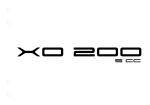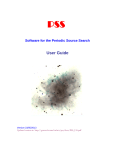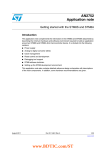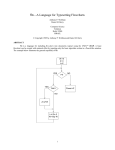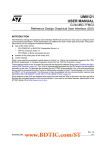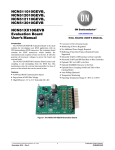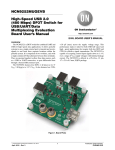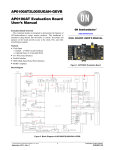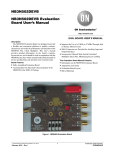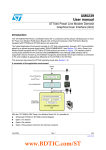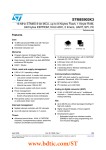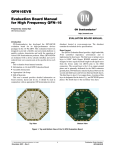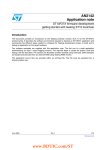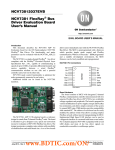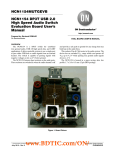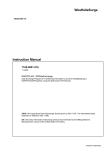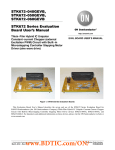Download EVBUM2115 - NCV7703 Evaluation Board User`s Manual
Transcript
NCV7703GEVB NCV7703 Evaluation Board User's Manual http://onsemi.com EVAL BOARD USER’S MANUAL Description • • • • • • • • • • The NCV7703 is a fully−protected triple half−bridge driver designed specifically for automotive and industrial motion control applications. The three half-bridge drivers have independent control. This allows for high-side, low side, and H-Bridge control. H-Bridge control provides forward, reverse, brake, and high impedance states. Driver control is accomplished via a standard Serial Peripheral Interface (SPI). The Evaluation Board includes both an NCV7703 and NCV8501 5 V regulator. By means of a jumper, the user can select an on−board or external VCC source for the IC. Numerous convenient terminal points are provided to accommodate multiple application configurations. • • • Features • Ultra Low Quiescent Current in Sleep Mode • Three High-Side and Three Low-Side Drivers Internal Free-wheeling Clamp Diodes Configurable as H-Bridge Drivers 0.5 A Continuous (1 A peak) Current Rdson = 0.8 W (typ) 5 MHz SPI Control with Daisy Chain Capability Compliance with 5 V and 3.3 V Systems Over Voltage Lockout Under Voltage Lockout Fault Reporting 1.4 A Over Current Threshold Detection with Optional Shutdown 3 A Current Limit with Auto Shutdown Over Temperature Warning and Protection Levels Internally Fused Leads in SON-14 Package Connected as Half-Bridges Figure 1. Evaluation Board Photo www.BDTIC.com/ON/ © Semiconductor Components Industries, LLC, 2012 May, 2012 − Rev. 2 Figure 2. Silkscreen Showing Component Positions of the NCV7703GEVB 1 Publication Order Number: EVBUM2115/D NCV7703GEVB SCHEMATIC VB+ 1 R3 10k U2 Vin Vout MON /Flag EN /Reset 45 Delay GND 2 3 +5V 8 7 6 GND GND OUT3 VS OUT1 OUT2 Vcc EN CSB SI NCV8501 C22 0.1uF SCLK SO GND GND Pinout 5V Vcc R9 100k C12 0.1uF D1 LEDSM EN R4 470 R1 1k EN U1 R8 100k SO EN SO 5 SI 6 SCLK CSB 4 R7 100 C16 10pF SCLK VCC 10 9 R2 100 SI 11 3 VS 1 GND 7 8 14 R6 OUT1 OUT1 13 GND OUT2 12 GND GND OUT3 2 100 OUT2 OUT3 NCV7703 C15 10pF CSB C7 C2 10nF 10nF C3 10nF R5 100 C14 10pF VB+ GND C5 330uF GND Figure 3. Evaluation Board Schematic www.BDTIC.com/ON/ http://onsemi.com 2 NCV7703GEVB Notice the SO of the SPI controller connects to the SI of the NCV7703GEVB, and the SO of the NCV7703GEVB connects to the SI of the SPI controller. The Enable jumper hard wires the Enable pin (EN) to be on. The Enable function may also be provided by the SPI Controller. Disconnect the Enable jumper when providing the signal externally. Refer to the data sheet for SPI interface functionality. Typical connections to the evaluation board are shown in Figure 4. The diagram illustrates half-bridge operation of a motor, and the option for a high-side or low-side load. The load connections are for illustration only and do not limit other possible connections. The connection of the battery or supply (to VB+) powers the board. VCC for the NCV7703 may be powered by the on−board regulator (powered from VB+) with the 5 V jumper. Remove the 5 V jumper if powering from an external source. LED D1 indicates when 5 V is present (powered on-board or externally). Figure 4. Typical NCV7703 Power Connections SPI Communication 3. CSB goes high to transfer the clocked in information to the data registers. Note SO is tristate when CSB is high. 4. The SI data will be accepted when a valid SPI frame is detected. A valid SPI frame consists of the above conditions and a complete set of multiples of 16 bit words. Standard 16-bit communication has been implemented for the communication of this IC to turn drivers on and off, and to report faults. The LSB (Least Significant Bit) is clocked in first. Communication is implemented as follows: 1. CSB goes low to allow serial data transfer. 2. A 16 bit word is clocked (SCLK) into the SI (Serial Input) pin. www.BDTIC.com/ON/ http://onsemi.com 3 NCV7703GEVB SPI Communication Frame Format chain communication between SPI compatible IC’s is possible by connection of the Serial Output pin (SO) to the input of the sequential IC (SI). The table below defines the programming bits and diagnostic bits. Fault information is sequentially clocked out the SO pin of the NCV7703 as programming information is clocked into the SI pin of the device. Daisy Table 1. PROGRAMMING AND DIAGNOSTIC BITS Input Data Bit Number 15 Output Data Bit Description Bit Status Bit Number Over Voltage Lock Out Control (OVLO) 0 = Disable 15 14 Not Used 13 Over Current Detection Shut Down Control (OCD) Bit Description Bit Status Power Supply Fail Signal (PSF for OVLO or UVLO) 0 = No Fault 14 Under Load Detect Signal (ULD) 0 = No Fault 13 Over Load Detect Signal (OLD) 0 = No Fault 1 = Enable 0 = Disable 1 = Enable 12 Not Used 12 Not Used 11 Not Used 11 Not Used 10 Not Used 10 Not Used 9 Not Used 9 Not Used 8 Not Used 8 Not Used 7 Not Used 7 Not Used 6 OUTH3 6 OUTH3 0 = Off 1 = On 5 OUTL3 4 OUTH2 0 = Off 5 OUTL3 4 OUTH2 OUTH1 3 0 = Off OUTL2 OUTL1 2 0 = Off OUTH1 Status Register Reset (SRR) 0 = Off 0 = Off 0 = Off 1 = On 1 0 = Off OUTL1 1 = On 0 0 = Off 1 = On 1 = On 1 0 = Off 1 = On 1 = On 2 1 = Fault 1 = On 0 = Off 1 = On OUTL2 1 = Fault 1 = On 1 = On 3 1 = Fault 0 = Off 1 = On 0 0 = No Reset Thermal Warning (TW) 1 = Reset 0 = Not in TW 1 = In TW Operational Recommendations Recommended operating voltages for this board are: Vbat+ = 13.2 V VCC = 5 V. This board is not reverse battery protected. Damage to the board may occur with incorrect connections. The NCV7703 device and C5 (aluminum electrolytic capacitor) are particularly sensitive to reverse battery conditions. See the NCV7703/D datasheet for electrical and environmental testing limits. www.BDTIC.com/ON/ http://onsemi.com 4 NCV7703GEVB Figure 5. Component Side Etch Pattern Figure 6. Reverse Side Etch Pattern Shown from Component Side www.BDTIC.com/ON/ http://onsemi.com 5 NCV7703GEVB BILL OF MATERIALS ON Semiconductor and are registered trademarks of Semiconductor Components Industries, LLC (SCILLC). SCILLC reserves the right to make changes without further notice to any products herein. SCILLC makes no warranty, representation or guarantee regarding the suitability of its products for any particular purpose, nor does SCILLC assume any liability arising out of the application or use of any product or circuit, and specifically disclaims any and all liability, including without limitation special, consequential or incidental damages. “Typical” parameters which may be provided in SCILLC data sheets and/or specifications can and do vary in different applications and actual performance may vary over time. All operating parameters, including “Typicals” must be validated for each customer application by customer’s technical experts. SCILLC does not convey any license under its patent rights nor the rights of others. SCILLC products are not designed, intended, or authorized for use as components in systems intended for surgical implant into the body, or other applications intended to support or sustain life, or for any other application in which the failure of the SCILLC product could create a situation where personal injury or death may occur. Should Buyer purchase or use SCILLC products for any such unintended or unauthorized application, Buyer shall indemnify and hold SCILLC and its officers, employees, subsidiaries, affiliates, and distributors harmless against all claims, costs, damages, and expenses, and reasonable attorney fees arising out of, directly or indirectly, any claim of personal injury or death associated with such unintended or unauthorized use, even if such claim alleges that SCILLC was negligent regarding the design or manufacture of the part. SCILLC is an Equal Opportunity/Affirmative Action Employer. This literature is subject to all applicable copyright laws and is not for resale in any manner. PUBLICATION ORDERING INFORMATION LITERATURE FULFILLMENT: Literature Distribution Center for ON Semiconductor P.O. Box 5163, Denver, Colorado 80217 USA Phone: 303−675−2175 or 800−344−3860 Toll Free USA/Canada Fax: 303−675−2176 or 800−344−3867 Toll Free USA/Canada Email: [email protected] N. American Technical Support: 800−282−9855 Toll Free USA/Canada Europe, Middle East and Africa Technical Support: Phone: 421 33 790 2910 Japan Customer Focus Center Phone: 81−3−5817−1050 ON Semiconductor Website: www.onsemi.com Order Literature: http://www.onsemi.com/orderlit For additional information, please contact your local Sales Representative www.BDTIC.com/ON/ http://onsemi.com 6 EVBUM2115/D







